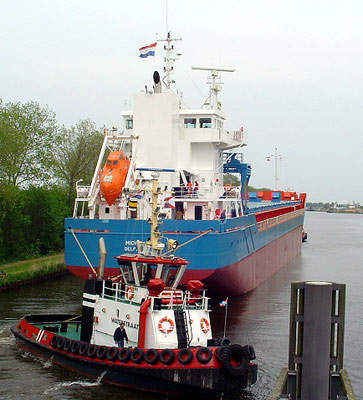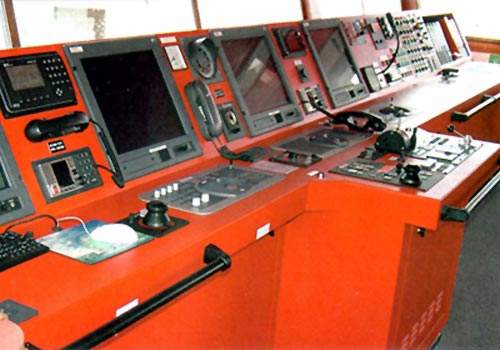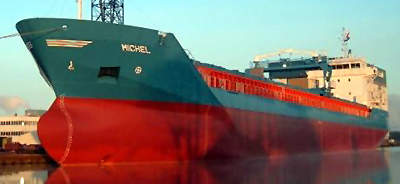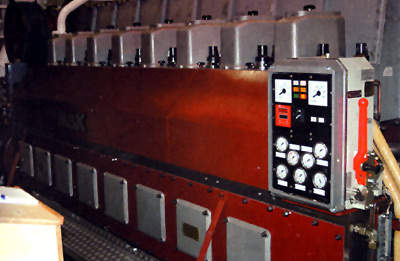The dry cargo vessel Michel was built by Ferus Smit at its Westyerbroek yard for the Belgian owners Switynk. The architectural layout is based on a raised forecastle and quarterdeck with two large box-shaped holds. These are each covered with hatch ways.
DESIGN
The ship has a length of 110m or 105m between perpendiculars and a 14m moulded breadth. The depth is 8.13m and it has a 6.09m draught. It has a 3,990t gross tonnage and a 6,000t deadweight.
Accommodation is located aft, with the wheelhouse on top of the superstructure. The navigation equipment includes an Arpa X and S band chart radar, two ECDIS chart pilots and a SAM 1100 track pilot. There is a Debeg 4630 Navigation and Echosounder, a DGPS and a correlation log.
There is also a magnetic compass and camera system, two gyrocompasses, a wind meter and a complete GNDSS radio system as well as iridium phones. The vessel’s HVAC system was supplied by York intl.
Safety systems include a 38m³/hr fire / water mist system and a CO2 system in the cargo hold. There is a Hatecke freefall lifeboat and two 12-man life rafts.
Cargo hold 1 has a length of 27.59m while cargo hold 2 measures 50.88m in length. Both holds have a common width of 11.5m and a 9m depth. The hatch covers have a cover load of 1.5t/m² and can handle a stack weight of 48t.
This translates as 104 TEU containers being able to be placed on the hatch covers. Conversely, the holds themselves have a stack weight capacity of 50t which means that 138 TEU can be placed in the holds. This gives the ship a total capacity of 242 TEU.
A travelling crane is used for stacking the containers and installing grain bulkheads. These two-part bulkheads can be placed in four separate locations. The hatch covers were supplied by Cops and Niebourg. To assist with the lading, there is also a pair of cranes with a capacity of 1,000kg.
Mooring is by a pair of SEC anchor handling/mooring winches located on the forecastle. These are connected to Wortelboer anchors by means of chain cables. Mooring winches and a drum are also present at the poop deck.
PROPULSION
The Michel is driven by a MaK 8M25 medium speed diesel engine. This developed 2,640kW at 705 revs/min. This is linked to a Flender GMCP 670 reduction gearbox by means of a Vulkan Benelux flexible coupling. The gearbox is connected to a 3.2m diameter Wartsila Lips 4D 1000 controllable pitch propeller.
The steering system is based on a Thefjord electro-hydraulic steering system connected to a Barke flap-type rudder. For manoeuvring in harbour, there is a 335kW Jastram bow thrusters.
There are two gen sets consisting of a Cummins 6 CTA 8.3D(M) diesel engine producing 140kW. This drives a 175kW Stamford UCM 274H generator. A HCM 534 E Stamford shaft generator is used for auxiliary power. This produces 240kW / 400 VAC. In emergency, there is a Stamford UCM 224E generator driven by a Cummins 4 BT 3.9 diesel engine.
The Michel’s tanks can hold 394m³ of heavy fuel oil as well as 45m³ fresh water, 44m³ diesel oil and for stability, 2,541m³ of water ballast. A Heatmaster hot water system, consisting of a 300kW heat exchanger, is used for heating the HFO tanks etc.
The fuel oil transfer is by means of an Azcue HFO pump. Alfa Laval supplied the self cleaning oil, diesel and lube oil separator. The tank sounding system is pneumatically controlled.
It is classified by Bureau Veritas under the notation Class 1A HULL and MACH, unrestricted navigation, AUT-UMS, ICE CLASS 1A, (Swedish-Finnish ice-class rules)





